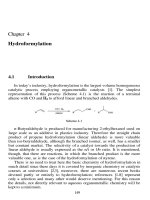Tài liệu Chapter 4: Motion in Two and Three Dimensions docx
Bạn đang xem bản rút gọn của tài liệu. Xem và tải ngay bản đầy đủ của tài liệu tại đây (263.02 KB, 16 trang )
Chapter 4
Motion in Two and Three Dimensions
In this chapter we will continue to study the motion of objects without the
restriction we put in chapter 2 to move along a straight line. Instead we will
consider motion in a plane (two dimensional motion) and motion in space
(three dimensional motion) The
following vectors will be defined for two- and three- dimensional motion:
Displacement
Average and instantaneous velocity
Average and instantaneous acceleration
We will consider in detail projectile motion and uniform circular motion as
examples of motion in two dimensions
Finally we will consider relative motion, i.e. the transformation of velocities
between two reference systems which move with respect to each other with
constant velocity
(4 -1)
Position Vector
The position vector of a particle is defined as a vector whose tail is at
a reference point (usually the origin O) and its tip is at the particle at
point P.
The position vectoExampl r in te : he f
r
r
igure is:
ˆ
ˆ ˆ
r xi yj zk= + +
r
( )
ˆ
ˆ ˆ
3 2 5r i j k m= − + +
r
(4 -2)
P
t
2
t
1
Displacement Vector
1 2
For a particle that changes postion vector from to we define the displacement
vector as follows:
r r
r∆
r r
r
2 1
r r r∆ = −
r r r
1 2
The position vectors and are written in terms of components as:r r
r r
1 1 1 1
ˆ
ˆ ˆ
r x i y j z k= + +
r
2 2 2 2
ˆ
ˆ ˆ
r x i y j z k= + +
r
( ) ( ) ( )
2 1 2 1 2 1
ˆ ˆ
ˆ ˆ ˆ ˆ
r x x i y y j z z k xi yj zk∆ = − + − + − = ∆ + ∆ + ∆
r
(4 -3)
2 1
x x x∆ = −
2 1
y y y∆ = −
2 1
z z z∆ = −
The displacement r can then be written as:∆
r
t
t + Δt
Average and Instantaneous Velocity
Following the same approach as in chapter 2 we define the average
velocity as:
displacement
average velocity =
time interval
ˆ ˆ
ˆ ˆ ˆ ˆ
avg
r xi yj zk xi yj zk
v
t t t t t
∆ ∆ + ∆ + ∆ ∆ ∆ ∆
= = = + +
∆ ∆ ∆ ∆ ∆
r
r
We define as the instantaneous velocity (or
more simply the velocity) as the limit:
lim
0
r dr
v
t dt
t
∆
= =
∆
∆ →
r r
r
(4 - 4)
t
t + Δt
2 2
If we allow the time interval t to shrink to zero, the following things happen:
1. Vector moves towards vector and 0
2. The direction of the ratio (and thus )approaches
t
avg
r r r
r
v
∆
∆ →
∆
∆
r r r
r
r
the direction
of the tangent to the path at position 1
3.
avg
v v→
r r
( )
ˆ ˆ ˆ
ˆ ˆ ˆ ˆ ˆ ˆ
x y z
d dx dy dz
v xi yj zk i j k v i v j v k
dt dt dt dt
= + + = + + = + +
r
(4 - 5)
x
dx
v
dt
=
y
dy
v
dt
=
z
dz
v
dt
=
The three velocity components are given by
the equations:
dr
v
dt
=
r
r
Average and Instantaneous Acceleration
The average acceleration is defined as:
change in velocity
average acceleration =
time interval
2 1
avg
v v v
a
t t
− ∆
= =
∆ ∆
r r r
r
We define as the instantaneous acceleration as the limit:
( )
ˆ ˆ ˆ
ˆ ˆ ˆ ˆ ˆ ˆ
lim
0
y
x
z
x y z x y z
dv
dv
v dv d dv
a v i v j v k i j k a i a j a k
t dt dt dt dt dt
t
∆
= = = + + = + + = + +
∆
∆ →
r r
r
The three acceleration components are given by
the equations:
x
x
dv
a
dt
=
y
y
dv
a
dt
=
z
z
dv
a
dt
=
Note: Unlike velocity, the acceleration vector does not have any specific relationship
with the path.
(4 - 6)
dv
a
dt
=
r
r









